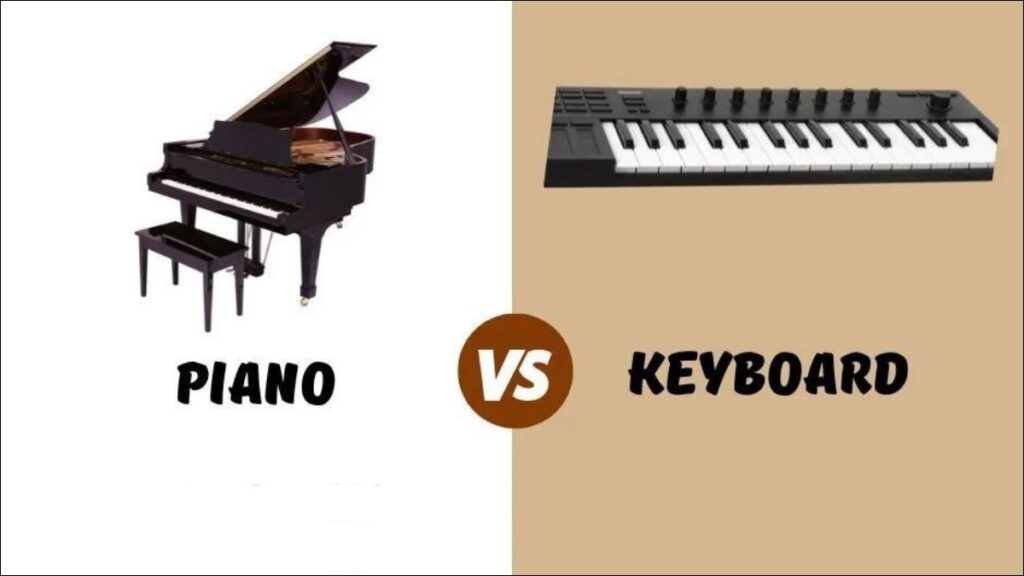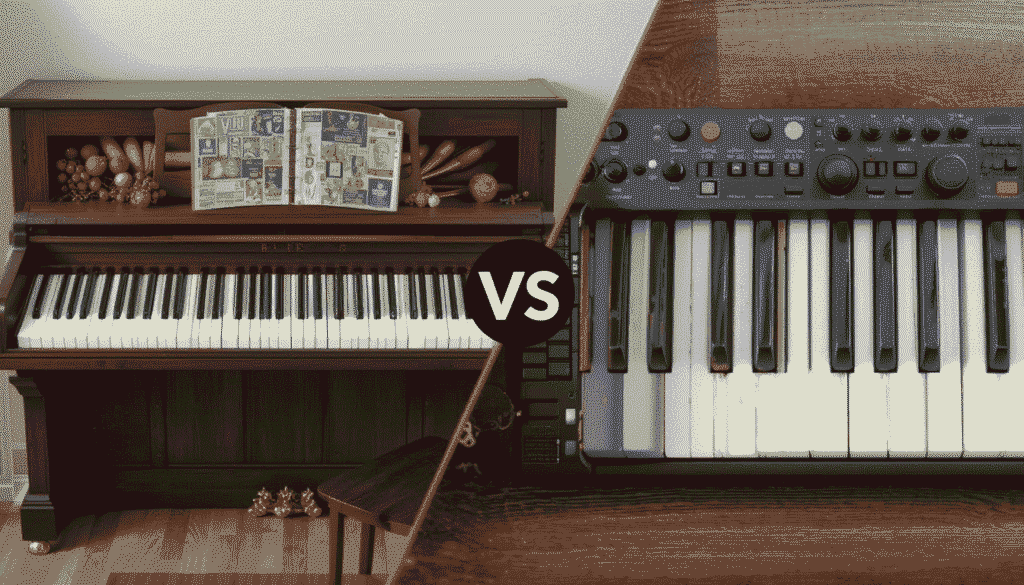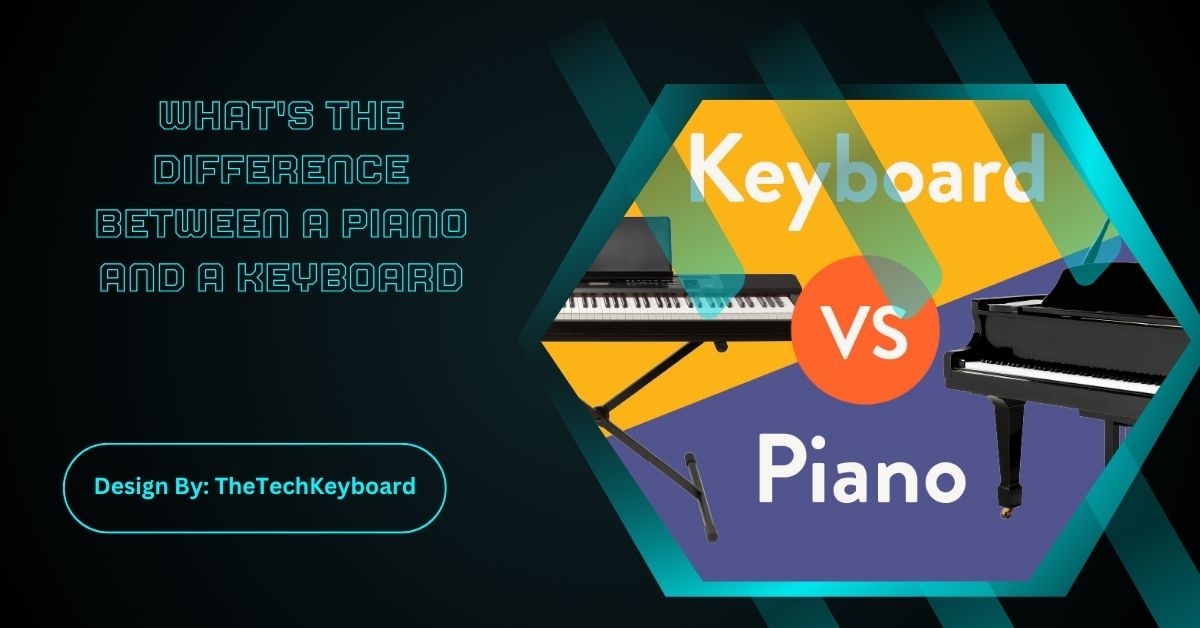Pianos produce acoustic sound with weighted keys, ideal for classical training. Keyboards are digital, portable, and versatile with built-in features, making them great for beginners, tech-savvy users, and music producers.
When it comes to learning a musical instrument, one common question is: what’s the difference between a piano and a keyboard? While they may look similar at first glance, these instruments differ significantly in design, function, sound, cost, and learning experience.
In this detailed guide, we’ll explore the key differences between a piano and a keyboard, help you decide which is right for your needs, and cover unique features that make each instrument special.
Physical Structure and Key Design
✅ Piano:
- A traditional acoustic piano has 88 weighted keys, usually made from wood and ivory or synthetic materials.
- It uses hammers and strings to produce sound when a key is pressed.
- The size is typically large and heavy, making it non-portable.
✅ Keyboard:
- A keyboard may have 49 to 88 keys, often made of plastic.
- Most do not have the same hammer-action mechanism. Instead, sound is generated electronically.
- Keyboards are lightweight and portable, often used with stands or desks.
Verdict: If you’re looking for a realistic and classic feel, the piano wins. But for portability and flexibility, the keyboard is ideal.
Sound Production

✅ Piano:
- Sound is produced mechanically through hammers striking strings.
- Offers natural tone and resonant acoustics.
- No electrical power is needed.
✅ Keyboard:
- Sound is produced digitally using pre-recorded or synthesized tones.
- Quality depends on the sound engine—some high-end keyboards emulate acoustic piano very well.
- Requires power or batteries to function.
Verdict: Pianos produce authentic acoustic sound, while keyboards provide digital versatility and effects.
Key Weight and Touch Sensitivity
✅ Piano:
- All keys are weighted and touch-sensitive.
- Allows dynamic control based on how softly or strongly you press the key.
- Encourages proper finger strength and hand posture.
✅ Keyboard:
- May come with semi-weighted, synth-action, or unweighted keys.
- Touch sensitivity varies by model.
- Higher-end models offer graded hammer action to mimic piano feel.
Verdict: For classical training and hand development, the weighted keys of a piano are preferred. However, keyboards offer a learning curve suited for beginners.
Learning and Practice Features
✅ Piano:
- Best for classical music education.
- Teaches you correct posture, strength, and dynamics.
- No built-in tools or aids.
✅ Keyboard:
- Includes learning modes, light-up keys, metronomes, and recording features.
- Often comes with MIDI and USB support for connecting to apps.
- Suitable for both beginners and casual learners.
Verdict: Keyboards are more beginner-friendly with built-in lessons and digital tools.
Price and Maintenance
✅ Piano:
- More expensive: ranges from $3,000 to $100,000+ depending on brand and type (upright, grand, baby grand).
- Requires tuning at least once or twice a year by a professional.
- Long-term investment but costly to maintain.
✅ Keyboard:
- Budget-friendly: $100 to $2,000+.
- No maintenance required.
- Easy to store, move, and upgrade.
Verdict: Keyboards are more accessible and affordable for most users.
Space and Portability
✅ Piano:
- Requires a large, dedicated space.
- Very heavy; not ideal for moving or small apartments.
✅ Keyboard:
- Compact and portable.
- Can be carried to gigs, lessons, or moved easily within your home.
- Foldable stands and carrying bags add extra convenience.
Verdict: Keyboards win in portability and space-saving functionality.
Musical Variety and Sound Options
✅ Piano:
- One iconic sound with limited variation.
- Best for pure, traditional music.
✅ Keyboard:
- Offers hundreds of instrumental sounds like guitar, strings, drums, synths.
- Great for composing, experimentation, and modern music.
- Includes rhythm patterns and background tracks.
Verdict: For creative versatility and electronic music, the keyboard excels.
Connectivity and Technology
✅ Piano:
- No connectivity options unless it’s a digital piano hybrid.
- Not compatible with software or DAWs (unless adapted).
✅ Keyboard:
- Comes with MIDI, USB, Bluetooth, and audio ports.
- Can be used with learning apps, recording software, or as a MIDI controller.
Verdict: Keyboards are tech-friendly and work well with digital audio workstations.
Which One Should You Choose?

Choose a Piano If:
- You’re learning classical music or taking formal lessons.
- You want an authentic acoustic sound.
- You have space and budget for a large, quality instrument.
Choose a Keyboard If:
- You need a portable or budget-friendly instrument.
- You prefer versatility and sound options.
- You’re a beginner, music producer, or casual player.
Digital Pianos: A Middle Ground?
If you want the feel of a piano and the features of a keyboard, consider a digital piano.
- Offers weighted keys, realistic sound, and compact design.
- Great for learners with limited space.
- Often includes headphone jacks, lesson modes, and recording capabilities.
Top Brands to Explore: Yamaha, Casio, Roland, Korg, Alesis.
Feature Comparison Table
| Feature | Piano | Keyboard |
| Keys | 88, fully weighted | 49–88, semi-weighted or synth |
| Sound | Acoustic, string resonance | Digital, multiple instruments |
| Price | Expensive | Affordable |
| Portability | Heavy, non-portable | Lightweight, portable |
| Learning Tools | None | Built-in lessons, metronomes |
| Connectivity | Rare (unless digital) | USB, MIDI, Bluetooth |
| Maintenance | Needs regular tuning | No maintenance required |
| Versatility | Limited to piano sound | Multi-instrument functionality |
FAQs:
1. Is a keyboard good enough to learn piano?
Yes, many modern keyboards have touch-sensitive and weighted keys, making them suitable for beginners. However, serious classical learners may benefit more from the feel and dynamics of an acoustic or digital piano.
2. Why are pianos more expensive than keyboards?
Pianos are crafted with wood, strings, and hammer mechanisms, offering rich acoustics. Their construction and tuning needs raise the cost. Keyboards, being electronic and mass-produced, are far more affordable and easier to maintain.
3. Can I use a keyboard for music production?
Absolutely. Keyboards with MIDI or USB connectivity are widely used in studios. They support digital audio workstations (DAWs), allowing you to compose, record, and edit music efficiently with a wide range of virtual instruments.
4. Which lasts longer: piano or keyboard?
Acoustic pianos can last decades with proper maintenance, often becoming heirlooms. Keyboards, while durable, may need replacement in 5–10 years due to software limitations or evolving tech standards. Digital pianos fall somewhere in between.
5. Are weighted keys necessary for learning?
Weighted keys help build finger strength and mimic acoustic piano resistance, improving technique. They’re not mandatory for beginners but are highly recommended for a more authentic learning experience and smoother transition to real pianos.
Conclusion:
Understanding the difference between a piano and a keyboard helps you choose the right instrument for your musical journey. While pianos offer unmatched acoustic quality and traditional feel, keyboards provide convenience, affordability, and versatility. Each has its strengths, from classical elegance to tech-savvy features. Whether you’re a beginner, composer, or serious student, there’s an option that fits your goals and space. The key is to get started and enjoy the process of learning and creating music with the instrument you love most.
Related Post:
- Driver Keyboard Sony Vaio Windows 7 – Complete Installation!
- Pedrovazpaulo Business Consultant – Modern Business Solutions!
- Prolink Keyboard Driver – Installation, Troubleshooting, and Full User Guide!
